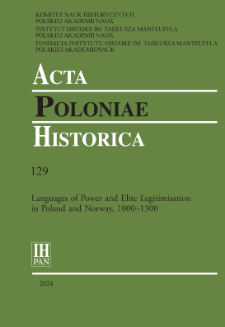
Object
Title: Holy Bishops, Papal Canonisation and the Legitimisation of Power in Thirteenth-Century Norway and Poland: The Cases of Eystein Erlendsson of Nidaros and Stanislaus of Kraków
Subtitle:
Acta Poloniae Historica T. 124 (2024), Languages of Power and Elite Legitimisationin Poland and Norway, 1000–1300 ; Languages of Power and Elite Legitimisationin Poland and Norway, 1000–1300
Institutional creator:
Polska Akademia Nauk. Komitet Nauk Historycznych
;
Polska Akademia Nauk, Instytut Historii im. Tadeusza Manteuffla
![]() ;
Fundacja Instytutu Historii im. Tadeusza Manteuffla Polskiej Akademii Nauk
;
Fundacja Instytutu Historii im. Tadeusza Manteuffla Polskiej Akademii Nauk
![]()
Contributor:
Instytut Historii Polskiej Akademii Nauk
Publisher:
Instytut Historii im. Tadeusza Manteuffla Polskiej Akademii Nauk ; Fundacja Instytutu Historii im. Tadeusza Manteuffla Polskiej Akademii Nauk
Place of publishing:
Description:
Abstract:
This article explores two mid-thirteenth-century attempts to canonise holy bishops from the so-called peripheries of Latin Christendom. That two ecclesiastical centres – the metropolitan see of the Nidaros Church Province and the episcopal see of Kraków – both sought to attain papal acknowledgement of the veneration of a holy episcopal predecessor and did so in the same historical period, is understood to be a response to a general trend in the Latin Church. More specifically, we interpret these attempts in light of the paradigm of the holy episcopal champion fighting for the freedom of the Church, a recalibration of the idea of the holy bishop that emerged as a result of the canonisation of Thomas of Canterbury in 1173, and which was promoted throughout the Latin Church from that point onward. Due to the popularity of the new type of the holy bishop, the episcopal champion became a form of symbolic capital that conferred greater prestige onto the saints, their cult centres, and the guardians of those cult centres, i.e., the clergy. Through a comparative study of two unconnected cases, we see how peripheral agents could actively adopt central trends to strengthen their own legitimisation of power vis-à-vis both rulers and other ecclesiastical institutions.
Relation:
Volume:
Start page:
End page:
Detailed Resource Type:
Format:
Resource Identifier:
oai:rcin.org.pl:241988 ; 2450-8462 ; 0001-6829 ; 10.12775/APH.2024.129.05
Source:
IH PAN, sygn. A.295/129 Podr. ; click here to follow the link
Language:
Rights:
Creative Commons Attribution BY 4.0 license
Terms of use:
Copyright-protected material. [CC BY 4.0] May be used within the scope specified in Creative Commons Attribution BY 4.0 license, full text available at: ; -
Digitizing institution:
Institute of History of the Polish Academy of Sciences
Original in:
Library of the Institute of History PAS
Projects co-financed by:
Access:
Object collections:
- Institute of History PAS > Serials
- Institute of History PAS > Institute Publications
- Institute of History PAS > Institute Publications > Journals
- Institute of History PAS > Institute Publications > Journals > Acta Poloniae Historica
Last modified:
Aug 2, 2024
In our library since:
Aug 2, 2024
Number of object content downloads / hits:
2
All available object's versions:
https://rcin.org.pl/ihpan/publication/278394
Show description in RDF format:
Show description in RDFa format:
Show description in OAI-PMH format:
Objects Similar
Pac, Grzegorz (1982– )
Pac, Grzegorz (1982– )
Strzelczyk, Jerzy (1941– ) Pac, Grzegorz (1982– ) Opaliński, Edward (1950– ) Janicki, Andrzej (1980– )
Pac, Grzegorz (1982– )

 INSTYTUT ARCHEOLOGII I ETNOLOGII POLSKIEJ AKADEMII NAUK
INSTYTUT ARCHEOLOGII I ETNOLOGII POLSKIEJ AKADEMII NAUK
 INSTYTUT BADAŃ LITERACKICH POLSKIEJ AKADEMII NAUK
INSTYTUT BADAŃ LITERACKICH POLSKIEJ AKADEMII NAUK
 INSTYTUT BADAWCZY LEŚNICTWA
INSTYTUT BADAWCZY LEŚNICTWA
 INSTYTUT BIOLOGII DOŚWIADCZALNEJ IM. MARCELEGO NENCKIEGO POLSKIEJ AKADEMII NAUK
INSTYTUT BIOLOGII DOŚWIADCZALNEJ IM. MARCELEGO NENCKIEGO POLSKIEJ AKADEMII NAUK
 INSTYTUT BIOLOGII SSAKÓW POLSKIEJ AKADEMII NAUK
INSTYTUT BIOLOGII SSAKÓW POLSKIEJ AKADEMII NAUK
 INSTYTUT CHEMII FIZYCZNEJ PAN
INSTYTUT CHEMII FIZYCZNEJ PAN
 INSTYTUT CHEMII ORGANICZNEJ PAN
INSTYTUT CHEMII ORGANICZNEJ PAN
 INSTYTUT FILOZOFII I SOCJOLOGII PAN
INSTYTUT FILOZOFII I SOCJOLOGII PAN
 INSTYTUT GEOGRAFII I PRZESTRZENNEGO ZAGOSPODAROWANIA PAN
INSTYTUT GEOGRAFII I PRZESTRZENNEGO ZAGOSPODAROWANIA PAN
 INSTYTUT HISTORII im. TADEUSZA MANTEUFFLA POLSKIEJ AKADEMII NAUK
INSTYTUT HISTORII im. TADEUSZA MANTEUFFLA POLSKIEJ AKADEMII NAUK
 INSTYTUT JĘZYKA POLSKIEGO POLSKIEJ AKADEMII NAUK
INSTYTUT JĘZYKA POLSKIEGO POLSKIEJ AKADEMII NAUK
 INSTYTUT MATEMATYCZNY PAN
INSTYTUT MATEMATYCZNY PAN
 INSTYTUT MEDYCYNY DOŚWIADCZALNEJ I KLINICZNEJ IM.MIROSŁAWA MOSSAKOWSKIEGO POLSKIEJ AKADEMII NAUK
INSTYTUT MEDYCYNY DOŚWIADCZALNEJ I KLINICZNEJ IM.MIROSŁAWA MOSSAKOWSKIEGO POLSKIEJ AKADEMII NAUK
 INSTYTUT PODSTAWOWYCH PROBLEMÓW TECHNIKI PAN
INSTYTUT PODSTAWOWYCH PROBLEMÓW TECHNIKI PAN
 INSTYTUT SLAWISTYKI PAN
INSTYTUT SLAWISTYKI PAN
 SIEĆ BADAWCZA ŁUKASIEWICZ - INSTYTUT TECHNOLOGII MATERIAŁÓW ELEKTRONICZNYCH
SIEĆ BADAWCZA ŁUKASIEWICZ - INSTYTUT TECHNOLOGII MATERIAŁÓW ELEKTRONICZNYCH
 MUZEUM I INSTYTUT ZOOLOGII POLSKIEJ AKADEMII NAUK
MUZEUM I INSTYTUT ZOOLOGII POLSKIEJ AKADEMII NAUK
 INSTYTUT BADAŃ SYSTEMOWYCH PAN
INSTYTUT BADAŃ SYSTEMOWYCH PAN
 INSTYTUT BOTANIKI IM. WŁADYSŁAWA SZAFERA POLSKIEJ AKADEMII NAUK
INSTYTUT BOTANIKI IM. WŁADYSŁAWA SZAFERA POLSKIEJ AKADEMII NAUK
































